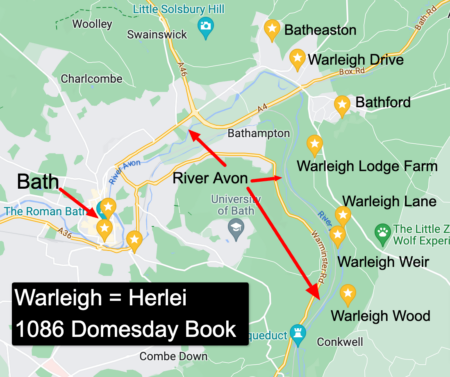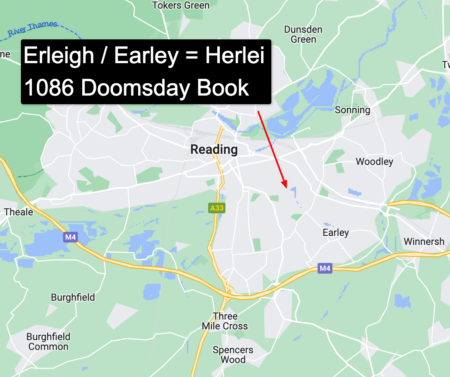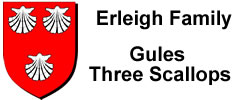
Welcome to the Earl, Earll, Earls, Earle, Earles Surname Family History
The Earl, Earll, Earls, Earle, Earles Surname
A member of the London Genealogical Society writes: “The family of Earle is of very ancient origin, and can be traced back, most probably, to a Saxon ancestor, prior to the Norman Conquest; but certainly I find evidence proving that, at the time of Henry the Second (who was crowned A. D. 1154), they were of Beckington, in the County of Somerset.”
The surname Erleigh / Earl / Earle has changed in spelling and has had many variations over the years.
In the British historical records, the surname has appeared as:
de Erleigh, de Erlegh, de Erleia, de Earley, de Erley, d’Erley, de Herlegh, de Arle, d’Arley Arrel, Hurley, Herlegh, Harley, Harle, Harlee, Harleye, Herleye, Erleg, Arleye, Erley, Erleye, Erle, Ernly, Earley, etc.
In more modern times, the name has been changed to Earl, Earll, Earls, Earle, Earles, and possibly Hurley and Searly and Darley.
The Land called Herlei (Erleigh) Berkshire and Somerset
Roman artifacts have been found at several sites in Earley. A Saxon settlement has been discovered in Reading at the confluence of the Kennet and the Thames, dating from about 600 AD.
Historical records show that the modern-day English Surname we know as Earle / Earl (or other variants) was derived from land ownership as a “place name” from the lands owned by the Erleigh family. These lands were recorded in the Domesday Survey of 1086. There were lands in the hundred of Sonning, Berkshire (modern-day town, spelled Earley) and lands in the hundred of Bath, Somerset (modern-day Warleigh), both called “Herlei” (Latin Spelling).
The Erleigh family was also granted additional lands, estates, and manors in the Hundred of North Petherton and The Hundred of Somerset during the reign of King Henry II (1135- 1189). The family holdings were enough that the family was considered to be minor Barons.
It is possible that the Erleigh family held these lands before the Norman Invasion of 1066, but the use of surnames didn’t begin until after the Norman Invasion.
After the “Norman Conquest” of England in 1066, William the Conqueror effectively confiscated most of the land in England from the Anglo-Saxon nobility. He redistributed land holdings to his Norman followers in exchange for loyalty and military service, essentially taking control of all land in the country and establishing a new feudal system.
These lands in Berkshire and Somerset, called “Herlei” or Erleigh, were recorded in the Domesday survey of 1086. The Berkshire “Herlei” land was previously owned (before 1066) by Almar the Saxon and, at the time of the survey, owned by King William the Conqueror. The Berkshire land had two manors, Erleigh Regis and Erleigh Bartholomew. The somerset “Herlei” land was previously owned (before 1066) by Azur (as Saxon) and, at the time of the survey, owned by Hugh the interpreter (probably a Norman).

Near Bath, Somerset land called Herlei (modern-day Warleigh)

Near Reading, Berkshire land called Herlei (modern-day Earley)
The Domesday survey completed in 1086 records two manors, Erlegh St. Bartholomew and Erlegh St. Nicholas. The de Erlegh family held the manors c.1100 – 1362. John de Erlegh in 1292, was known as the White Knight – thus, the estate of St Nicholas was renamed Whiteknights Manor. The other Manor also had a name change to Erlegh Court. The Manor of Maiden Erlegh, Erley Maydens, is attested from 1502, and it was formed out of Earley Whiteknights in the 14th Century.
This is the Domesday entry for one of the manors in Erleigh called Erleigh Regis, later called Erleigh Whiteknights, near Reading in Berkshire, held by Almar. We read that in 1086, it was held directly by the King. Another neighboring manor, also called Erleigh Bartholomew, was held by a Norman tenant of the King, Osbern Giffard.
The Domesday Book is written in heavily abbreviated Latin with small marks to show where a letter or letters have been left out, to save space.
The following is an expanded translation (Domesday words directly translated in bold) of the entry for the royal estate and manors of Erleigh (Latin Herlei), Berkshire:
The King (William the Conqueror) holds in demesne Erleigh (in lordship – that is, by and for himself; he has not let it out to a sub-tenant). Almar (an Anglo-Saxon) previously held it in alod (freehold, which means land that was owned outright and could be passed down or sold by the owner) from King Edward (The Confessor). Then (previously in 1066, it was assessed for tax purposes) at 5 hides, now (in 1086, it is assessed) for (the equivalent of) 4 hides. (There is) Land for use by 6 ploughs. In demesne (on the lord’s land there is land for) 1 plough and (there are) 6 villans (villagers) and 1 bordar (smallholder) with 3 ploughs. There (are) 2 slaves (owned by the King) and 1 site (or close) in Reading (presumably owned by or part of the manor) and (there are) 2 fisheries worth (rendering) 7s and 6d (per year) and 20 acres of meadow. (There is) Woodland for (feeding) 70 pigs. At the time of King Edward (1066) it was worth 100s, and afterwards (when William acquired the manor) and now (1086) it is worth 50s.
Source: https://www.nationalarchives.gov.uk/domesday/discover-domesday/interpreting-domesday.htm
The Herlei of 1086, the Great Survey, records a population of 21 people, although it is thought likely a truer figure would be around 100.
DNA Testing
Are People with the Earle Family Name Related?
Two people can share a surname and have no biological relationship with each other. Sometimes, children were adopted or other circumstances occurred, and those not of the bloodline took the surname.
DNA testing (specifically y-DNA testing) shows that not everyone with the surname Earle is related biologically. We encourage any male with the last name Earle or a variation of Earle to take a y-DNA test. The y-DNA test is for the male line only and can help all of us understand our Earle heritage.
The Y chromosome passes almost unchanged from father to son. Male ancestors carried their Y-DNA line along their migrations, allowing you to trace your paternal ancestry using our advanced Y-DNA tests and the world’s largest Y-DNA database.
Special sections on the Y chromosome determine a male’s Y haplogroup, revealing the origins of his ancestors as evidenced by common DNA markers.
Y-DNA test results of 2 people who have a documented lineage to Edward Earle (b. 1628) of Secaucus New Jersey show a general Y-DNA Haplogroup of R1A
We need Y-DNA tests for any known descendent of Ralph Earle (b.1606) of Rhode Island.
We also need Y-DNA tests for any known descendants of the Maryland, North Carolina, South Carolina, and Virginia Earle families.
Join the Earle Surname Project at Family Tree DNA
We recommend FamilyTreeDNA for testing.

